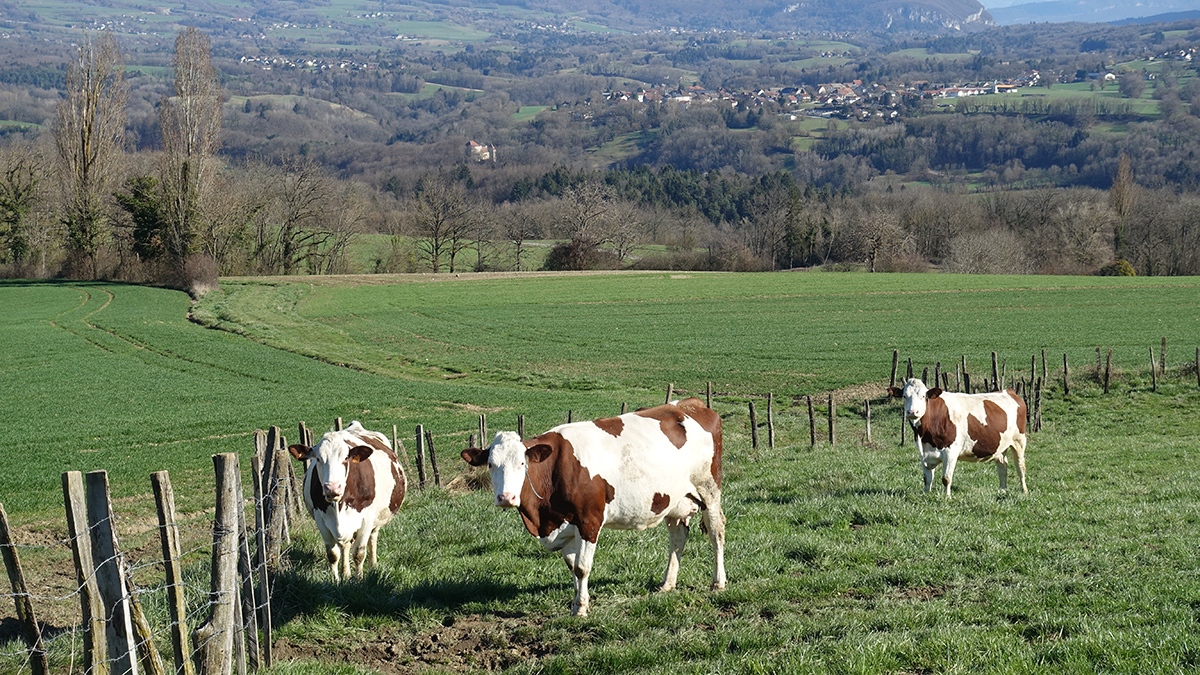A translation of this article was made possible by a partnership with Planeteando. Una traducción de este artículo fue posible gracias a una asociación con Planeteando.
On a summer day not long ago, 10 people gathered to eat cheese in the name of science. They nibbled on small rounds of Cantal, a firm cow’s milk cheese historically produced in south central France, and evaluated more than 25 attributes spanning color, odor, taste, aroma, and texture. The tasting was just one component of a larger study on the effects of shifting cows’ diets from grass to corn because of industrialization and climate change. The new findings highlight the importance of maintaining at least some grass in cows’ diets.
“Their physiology and digestive tracts are made to digest grass.”
Cows, with their four stomach pouches, are evolutionarily primed to consume grass and extract all the nutrients possible from that roughage. “Cows are herbivores,” said Elisa Manzocchi, a dairy researcher at Agroscope in Posieux, Switzerland, who was not involved in the research. (Agroscope is a Swiss governmental organization devoted to agricultural research.) “Their physiology and digestive tracts are made to digest grass.”
But bovines around the world are increasingly being fed a corn-based diet as industrial-scale farming proliferates—it’s often easier, more efficient, and more scalable to feed cows from a trough rather than allow them to forage in a pasture.
Climate change is also driving that shift. Even in regions that have long turned cows out to green pastures, farmers are facing summertime grass shortages due to droughts. That’s true in Marcenat, the site of an experimental farm run by the National Research Institute for Agriculture, Food and Environment (INRAE), said Matthieu Bouchon, an animal husbandry scientist there. It’s hotter in the summer than it used to be, but there’s still a lot of spring rainfall, he said. “The conditions are perfect for corn cultivation.”
Seeing cornfields in Marcenat, a mountainous region in south central France at an elevation of 1,000 meters, is jarring, Bouchon said. “It’s not something we’re used to.”
Bouchon and his colleagues at INRAE, led by microbiologist Céline Delbès, recently investigated how changing a cow’s diet has a slew of trickle-down effects on the quantity, quality, nutritional value, and flavor of its milk and resultant cheese. Earlier work compared outcomes of grass- and corn-fed diets in cows, Manzocchi said, but this investigation is particularly thorough. “It’s one of the first studies where they looked at many parameters.”
Soil to Grass to Cow to Milk to Cheese
The team focused on 40 Prim’Holstein and Montbéliarde cows, dividing them into two groups: one fed a largely grass-based diet and the other fed a corn-based diet with some access to pasture grass. After 2 months, half of the cows in the first group were switched to a less grass-based diet, and half of the cows in the second group were entirely denied access to pasture grass. The result was a cohort of four bovine groups that for nearly three more months, ate roughly 75%, 50%, 25%, and 0% grazed grass, respectively.
Throughout the experiment, Delbès and her collaborators collected milk samples two times per week (the cows were milked twice per day), soil samples from the pasture grass, and even swabs from the cows’ udders. The goal was to better understand how a dietary shift induced by climate change translates into changes in the attributes of a herd’s milk and, ultimately, cheese. “There were a lot of things in this experiment,” Bouchon said.
The researchers enlisted the help of a cheese-making facility near the farm to produce small rounds of Cantal cheese, each weighing about half a kilogram, using milk from the cows in each of the four groups. The cheeses were aged for 9 weeks before being served to panelists trained in tasting Cantal-type cheeses.
Preserve the Grass
Consistent with previous findings, the researchers found that cheese made from milk from cows fed primarily grass were more flavorful and had higher levels of certain fatty acids compared with cheeses produced from cows primarily fed corn. However, cows fed diets with a higher proportion of grass also yielded less milk relative to the amount of food they consumed, the team noted.
Overall, Delbès and her collaborators found that the shift from a diet of 25% grazed grass to one of 0% grazed grass was more detrimental to a cheese’s nutritional and sensory qualities than the shift from a 75% grazed grass diet to a 50% grazed grass diet.
“It’s surprising that just a quarter of the diet can do so much [to affect] the sensory quality of the cheese.”
The finding suggests that maintaining at least a modicum of fresh grass is critical to ensuring quality cheese, Delbès said.
“It’s surprising that just a quarter of the diet can do so much [to affect] the sensory quality of the cheese,” Manzocchi said. But perhaps that finding should be reassuring to traditional cheese producers who might no longer be able to feed their herds a largely grass-based diet, she added. “Maybe it’s good news.”
Delbès and her team aren’t yet finished with their Prim’Holstein and Montbéliarde herds. Future work will focus on examining how microbes present in the soil and bedding areas of the cows, for example, are correlated with microbes present in the human gut after cheese is consumed.
—Katherine Kornei (@KatherineKornei), Science Writer
28 May 2025: This story has been updated to correct the location of the experimental farm.

